Submitted by Momoh Kakulatombo
Aaki Consultants designs Kenya’s National Library, inspired by the Iconic African Drum
Kenya Architecture News - May 19, 2017 - 18:07 23271 views
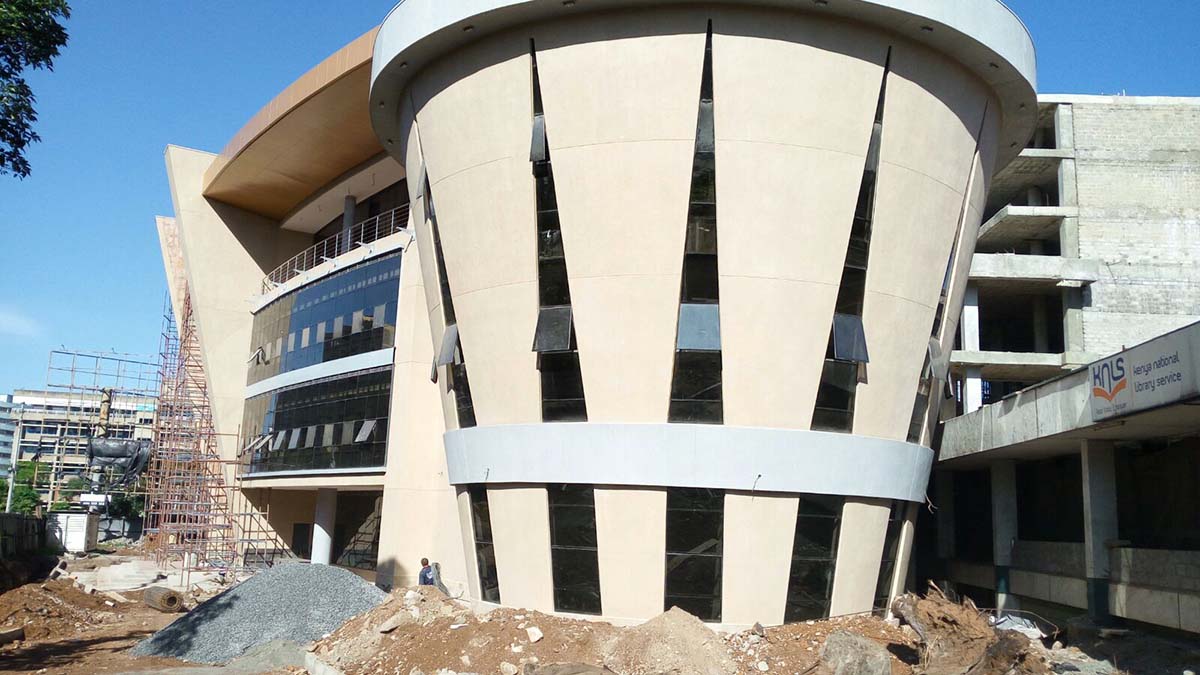
Standing on Ngong road in Nairobi’s Upper Hill area, right ahead of you is the African-inspired Library. It is easy to work your eyes up the widening profile of the dramatic cone. The triangular-inclined tinted windows, shape a pattern that prompts you to suspect its cultural symbolism. No, this is not a take away coffee cup. This appearance characterizes the majestic new building designed by Aaki Consultants, a well-established local architecture firm in Kenya.
The Kenya National Library building is under construction and is less than 10Kms west of downtown Nairobi. The locale has a number of tall government offices nearby with beautifully sun-shaded façades. The recent office tower developments, to the east and west, now crop this picture of Upper Hill into Nairobi’s next business district.
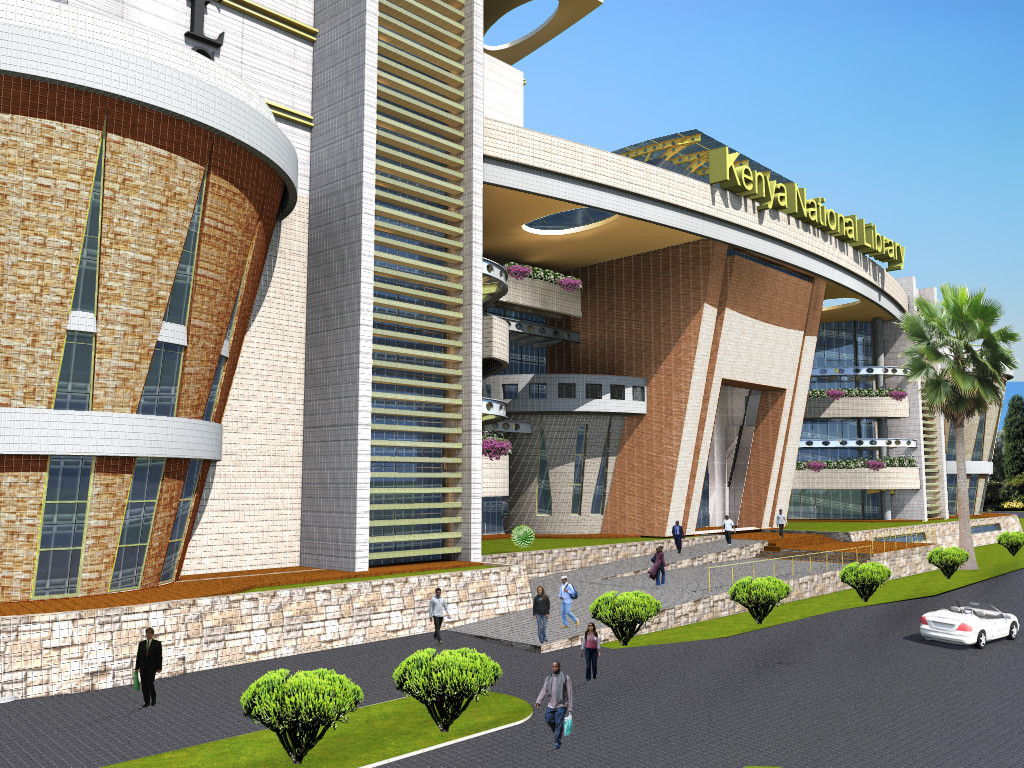
Over the past two decades, AAKI Consultants have pioneered a sustainable approach to architecture. Their recent work includes an office tower at Jomo Kenyatta University Agricultural Technology (JKUAT) and the Barclays Plaza towers among other architectural Projects.
The Kenya National Library Service (KNLS) are the clients of the project. Improving the traditional relationship between its patrons and learning is the motivation behind this project. This development is funded for by the Government of Kenya. The National Library of Kenya is a Flagship project of Vision 2030, a strategy to enhance Kenya’s growth by focusing development on key socioeconomic elements.
The Director and CEO of KNLS, Mr. Richard Atuti, captured the motivation behind this scheme: "By innovating Kenya’s reading culture, we achieve our organizations’ mission of empowering communities", says Mr. Atuti.
Kenya’s National Library building is created with the mission to keep and preserve the ‘National Imprint’ and to make this knowledge accessible to the public. It is a legal deposit library, receiving copies of all literature, audio, video and newspapers produced in Kenya including records of government publications and many kinds of literature published in Kenya; the library will also support research for innovation and development.
Kenya has 42 distinctly identified cultures. Given this fact, the political idea at the heart of this architecture is to unify Kenya’s diverse population in their search for knowledge. An African drum, by example, sends forth a familiar rhythm. With sophistication, the library rhymes with its contextual surrounding.
In the rendering, a wide plain of outdoor gathering space for the public, borders the buildings’ envelope. The National library is divided into two phases. Phase one will host the five-story National library. Entering the majestic main entrance, visitors will find a gallery space on the first floor which will feature unique artwork from select artists. On the interior, distinctive wall murals will thread the aisles, and community spaces with the deep identity of Kenya so the Library’s presence speaks on the inside as well as the outside. Phase 1 will be completed in August 2017. Phase 2 will house commercial spaces that will generate revenue and help sustain the library’s functions independently.
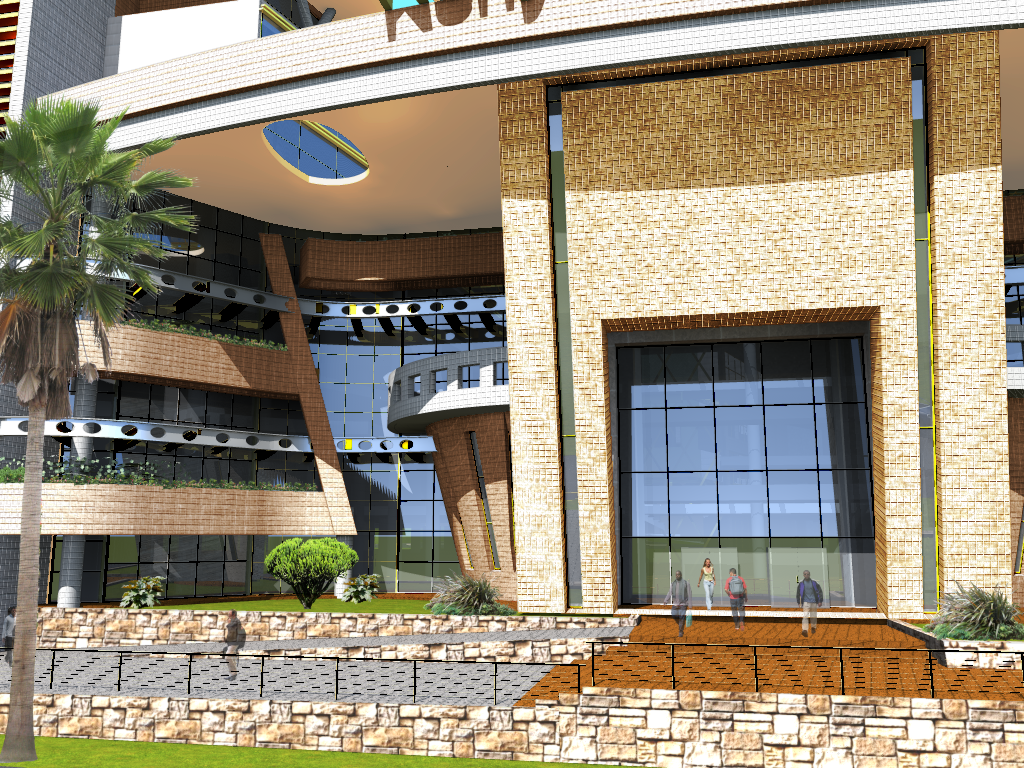
Upwards from the ground floor to the third floor, there will be the varied library sections. Besides the sections, Commercial spaces on each floor provide a sustaining basis for the library’s operations. Planned side by side with this, visitors will have the freedom to read leisurely at a restaurant, a reasoned place of relaxation for the mind.
The fourth and fifth floors are reserved for the administrative offices of KNLS and various government bodies. Crucially, a digital network offering online resources is set up to accommodate different public uses and changing technologies for connecting to the library virtually. At the same time, Deputy Director of KNLS says: "The internet has made it easy for the library to carry out online services to those who have access."
Enclosed within the powerfully- scaled drums are community spaces. Each one of the three drums feature a kind of performance space on program: the children’s theatre, the auditorium and the e-book library. Rhetorically, the architecture’s drums simulate the resonance of a working drum. In full splendor, they anchor the building visually as a focal point on the landscape.
Speaking of the potential power of a National level library, Mr. Atuti says, "education is the equalizer. Therefore, The National Library is the People’s University".
Certainly, the National Library is the nerve-center of all other libraries in any Country. Mr. Atuti and Mr. Wafula detailed an extensive investigation which led them to a solution embodying this property. Benchmarking upon library standards from around the world, they identified aspects of an ultramodern or a hybrid Library:
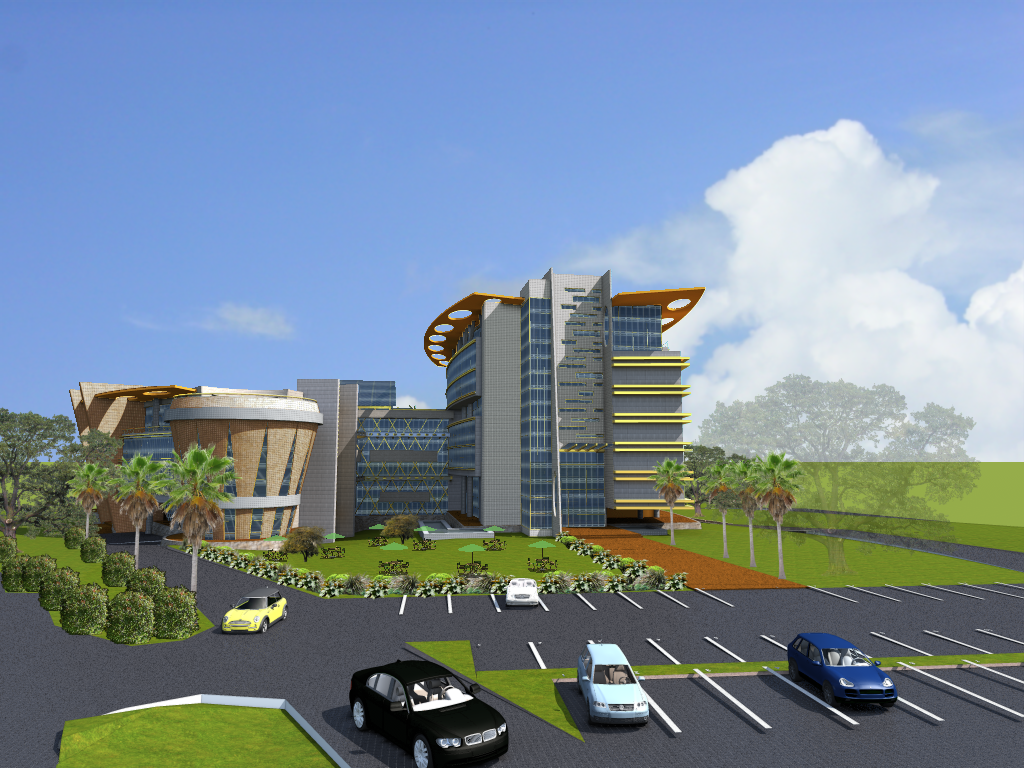
First, functionality:
On location at their offices, Mr. Charles Githinji let on a key fact: "The reading floors have a height of 4.5 meters, to maximize natural lighting for the readers."
Nairobi is very near the equator line and the building is oriented on a North – South axis to optimize day lighting opportunities affording readers a pleasant experience within, plus, tinted windows decrease the UV rays permitted and make for a graceful experience.
Further comfort for library patrons is promoted by natural air ventilation utilizing "stack effect" – a system controlling of convection air currents moving through the building to escape via the open atrium. Louvered air vents on the exterior continually fill the vacuum left with cool air.
In terms of sustainability, the library will prove efficient for the next 100 years. Through sourcing solar power, daylight management, water harvesting methods the library show a sensitive carbon footprint is intended. As for the scale of preservation, a minimum capacity of holding 2,000,000 books enable it to perform its function exceptionally. The library has a capacity to hold 7,000 – 10,000 people per day! "We expect to have a traffic of about 5,000 visitors per day once the library opens officially", says Mr. Atuti.
Secondly, a Wow factor:
Popular success relies largely in part on meaning a building holds and imparts. In a natural way, libraries – which preserve knowledge, relate wholesomely with the values a society holds.
This contemporary feel opens this value to pedestrians walking on neighboring sidewalks. It is hard to miss the conceptualized correlation between the African drum and the architecture of the library. This building rises in the horizon as one gets closer. The familiarity of the structure is a message to passersby about communication and information contained in the building. Mr. Mwangi also elaborated how the African Drum carries an intended meaning in this specific context: "Its use as a communicative tool, is the understanding we have abstracted in our design".
Knowledge is preserved in the drum
The historical context of the African drum is a valuable golden folklore. Most notably in ancient times the world over, drums made it easy to communicate over long distances. Messages could easily travel from village to village using a special drum language based on the accented patterns of speech of a tribe.
Furthermore, throughout many African cultures, Drums play a significant role in community relationships. In ceremonies and festivities, drums are played in ways to suit the occasions and conjure emotions. The complex rhythm of drums was the cultural route to acknowledging life’s moments, sometimes expressed through passionate dance. African arts as an expression of lifestyles have always aimed at expressing and celebrating the moral values that sustained the community. The drum has an established place in an African setting and has become a universal social tool, an art décor and musical instrument.
The drum confer status to their owners in Africa, distinguishing people of different ranks in society. There are different types of drums. Congas, sabar, bongo, djembe, bougarabou, talking drum, udu; the drum was integrated into daily life of Africans. Some drums were used to store cereals or grain in their hollow part. Selflessly, the architecture of the library uses the African drum technique for grain/cereal storage symbolically preserving knowledge for the future. This is food for thought!
According to USI, until recently, many commentators on Africa claimed that African societies had no tradition of writing. With the rediscovery of ancient manuscript collections, some dating back to the 8th century AD, this perception is changing.
History is unearthed and explored in this concept. Thinking back a bit, we can imagine sites of ancient libraries in Africa; the revered 14th Century desert Libraries of Timbuktu, the library of Alexandria in Egypt make an important historical precedent for Kenyan library. The National Library is in a way a resurgence of an Africa-wide spirit and offers a fresh perspective on these parts of Africa’s ancestry by reusing the intellectual heritage of African drums.
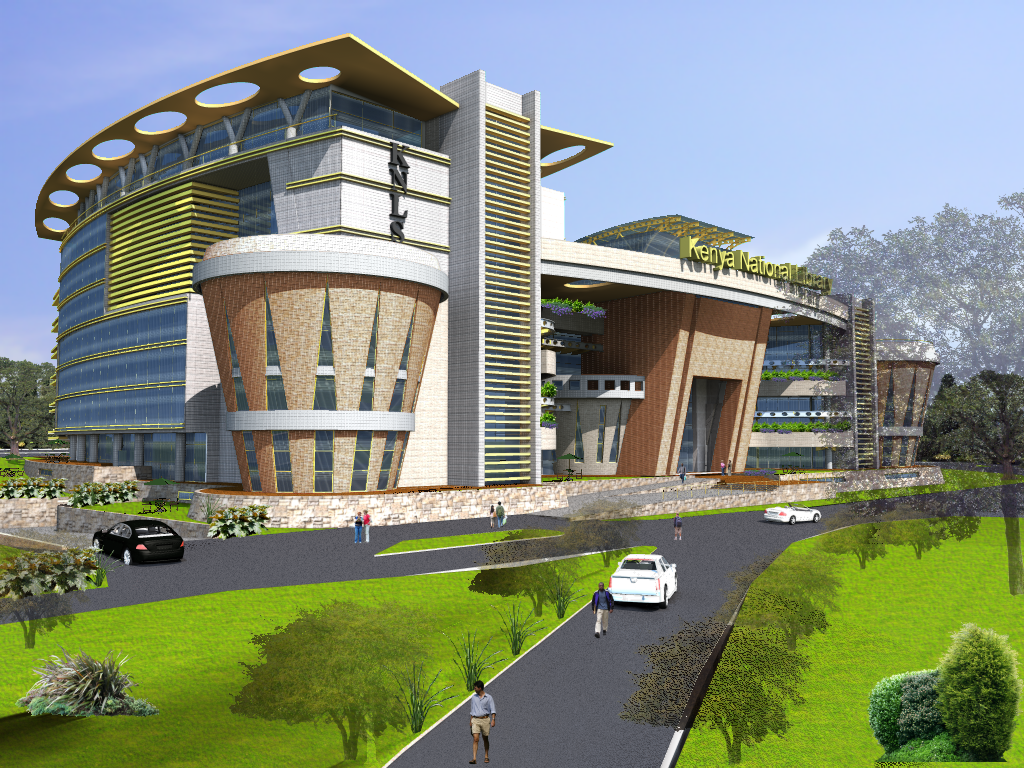
The physical presence and looks of this National Library influences the people’s relationship to the building. In the understanding of the client and the designers, this library is taken to be an activity, open to the infinite definitions that the public may bring. It is the act of communicating knowledge today that is echoed in the symbolic drums and gives a new shape to fundamentals of reading and learning in Kenya.
An inventive African cultural relic fused with modern idiomatic design produces a magnificent reading space, a great landmark in Nairobi, Kenya. The new National Library beckons library patrons to dance to the rhythm of learning!
Project Facts
Project Name: National Library of Kenya
Location: Nairobi, Kenya
Client: Kenya National Library Service
Architect: Aaki Consultants
Project Directors: Richard Atuti (KNLS Representative/Project Manager), Francis Mungai (Principal at Aaki Consultants/Lead Designer), Charles Mwangi (Project Architect/Associate Architect at Aaki Consultants)
Site Area: 3 acres
All Images © Aaki Consultants
> via Aaki Consultants
